Vietnam celebrates the Lunar New Year. It is called Tet (Tet) and is celebrated on the first day of the first lunar month in the first season of the new year. The date of the new year on the eastern calendar moves from year to year between January 20 and February 20.
Lunar New Year is often referred to as Chinese New Year. This is not surprising, because the traditions and culture in the countries of East Asia came from China.
On Tet, everything is filled with joyful anticipation of a big holiday and has a ritual character. Even the banal cleaning of the house before the New Year does not seem to be a burden and is accompanied by the ritual of sending the God-hearth to heaven to report to the Jade Emperor on family affairs over the past year and the ritual of meeting him back to earth to mark the beginning of the year with his family in a clean, tidy house .
In Vietnam, the role of the New Year tree is solemnly performed by bamboo, which grows in everyone's yard. Its trunk is decorated with red paper - as a symbol of prosperity and prosperity.
Tet is also a festival of flowers. Driving to the flower markets is prohibited. And it would hardly occur to anyone to interfere in this way with a happy New Year's fuss.
Matcha is considered the most festive flower - a sunny flower, or oriental "aster". And these flowers, says the folk wisdom of the East, should be as many as there are people on Earth.
Vietnamese New Year Customs
In the north of the country, a blossoming peach branch is installed in the house on New Year's Eve or decorated with tangerine trees hung with orange fruits, symbolizing prosperity.
During this period, peach and apricot trees, tangerines and almonds bloom. The streets are decorated with young flowering branches and simply bouquets of flowers.
In the south of the country, on Tet, they prefer to decorate their house with a blossoming apricot branch, moreover, apricot flowers should have five petals. In addition, the southerners put watermelons on the altar, the red sweet pulp of which symbolizes good luck in the coming year.
 Regardless of the wealth of the family, before the New Year, people try to buy food, fruits, flowers, sweets in order to prepare a sacrifice on the altar of their ancestors and treat relatives and guests for three holidays.
Regardless of the wealth of the family, before the New Year, people try to buy food, fruits, flowers, sweets in order to prepare a sacrifice on the altar of their ancestors and treat relatives and guests for three holidays.
The Vietnamese New Year Tet has centuries-old traditions. Exactly at midnight, festive fireworks explode the sky of Hanoi and Haiphong, Da Nang and Ho Chi Minh City. In temples and pagodas, beats of copper bells and the sound of wooden armchairs sound. Young people carry painted paper and cardboard dragons through the streets and squares.
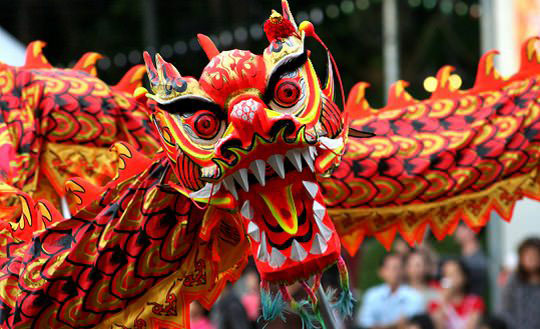 The festive decoration is dominated by red and yellow colors.
The festive decoration is dominated by red and yellow colors.
Vietnamese women in Tet wear red and yellow clothes, while the men are dressed in all black. In mountainous areas where national minorities live, the celebration is slightly different.
 At dusk, bonfires are lit in parks, gardens or on the streets, and several families gather around the bonfires.
At dusk, bonfires are lit in parks, gardens or on the streets, and several families gather around the bonfires.
In the morning you should go in search of a flower with dew drops on the petals, pick a branch of a peach tree, give gifts to children. By following these rituals, evil will never enter your home.
On the second day of Tet, on the territory of the oldest temple in Indochina, Van Mieu, the most cheerful and fierce cockfights flare up.
On the Lake of the Returned Sword in Hanoi, the water puppet theater, a unique folklore troupe, gives performances.
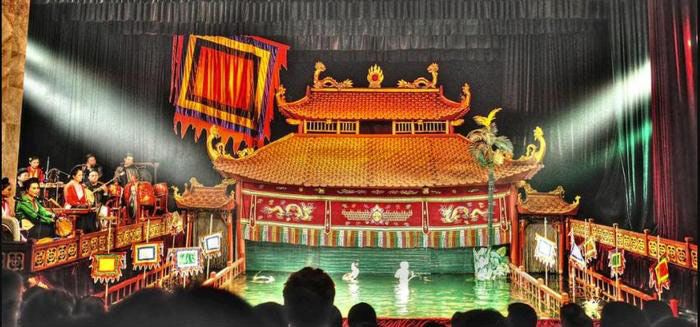 In the historic center of Hanoi, on Hangluok Street, old people kindly offer long bamboo poles. They must be "planted" in front of the entrance to the house - they will block the way for evil spirits.
In the historic center of Hanoi, on Hangluok Street, old people kindly offer long bamboo poles. They must be "planted" in front of the entrance to the house - they will block the way for evil spirits.
But the most important thing on New Year's days is not to wish misfortune to another: observance of good rules will give peace and happiness to you and your loved ones.
New Year's Eve in Vietnam
Special delicacies from rice are prepared on coals. In the north of the country - these are pork legs with bamboo sprouts, meat jelly, carp in salty sauce.
In the south, pork in a pot boiled in salted coconut milk, while the whole pork is boiled in coconut milk, with skin, fat and lean parts. In the finished dish, the fatty part looks transparent, and the lean part looks bright red, with the taste of coconut milk.
On the table of southerners there are also pickled green pea sprouts with leeks, slices of carrots, turnips, bitter melon stuffed with meat.
It is believed that bitter melon has antipyretic properties, it is very nutritious and cures many diseases.
A ubiquitous dish is the banh chung square pie, which is one of the most famous dishes in Vietnamese cuisine. It is made with pork rice, green peas and pickled onions wrapped in bamboo leaves. According to the recipe, it is made very long and carefully - cooking takes more than a day.
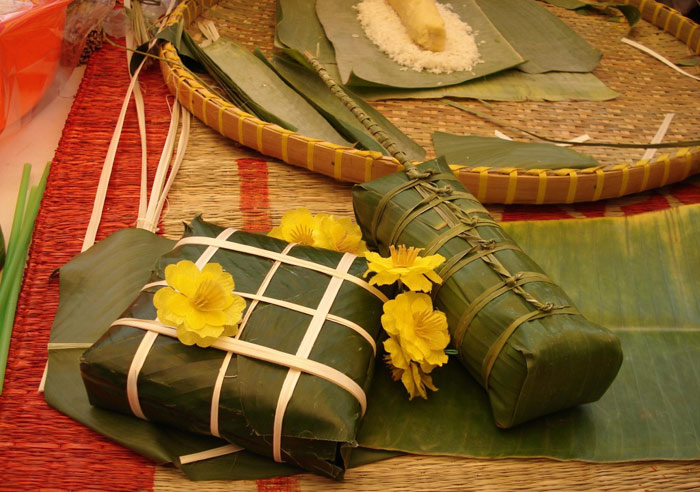 According to legend, banchung appeared under King Hung, the founder of the nation, 3-4 thousand years ago. Prince Lang Lieu, one of the king's sons, made round and square pies: round bandai symbolizes the sky, and square ban ching symbolizes the earth, and together - the world under a common roof, and presented them to his father on the occasion of the coming of Spring.
According to legend, banchung appeared under King Hung, the founder of the nation, 3-4 thousand years ago. Prince Lang Lieu, one of the king's sons, made round and square pies: round bandai symbolizes the sky, and square ban ching symbolizes the earth, and together - the world under a common roof, and presented them to his father on the occasion of the coming of Spring.
And since then ban ching has become an obligatory dish during the celebration of Tet. All of its ingredients, from the green leaves in which it is wrapped, to the rice and pork, green peas and peppers inside, are medicines that maintain harmony between Yin and Yang, thereby promoting blood circulation and preventing disease.
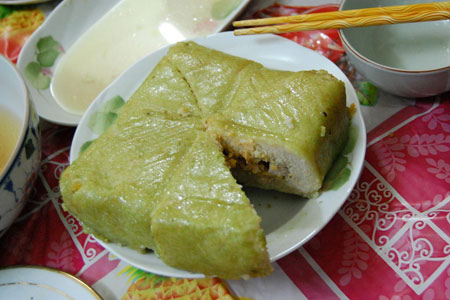 There are no other pies in the world with such great cultural significance and as useful in medical terms as the Vietnamese green banh chung pies.
There are no other pies in the world with such great cultural significance and as useful in medical terms as the Vietnamese green banh chung pies.
How Tet is met in families
At night, at 12 o'clock, children and grandchildren congratulate their grandparents, parents and wish longevity, good health and prosperity. This time is called "Ziao Tkhia" (meaning "meeting of times").
It is considered honorable to spend New Year's Eve in the company of a gray-haired man who is over 70 years old.
Then the adults congratulate the children and give money for happiness. The money must be new, bills or coins, and packed in new red paper or cloth bags with a red bow.
The next day is usually the Tet festival.
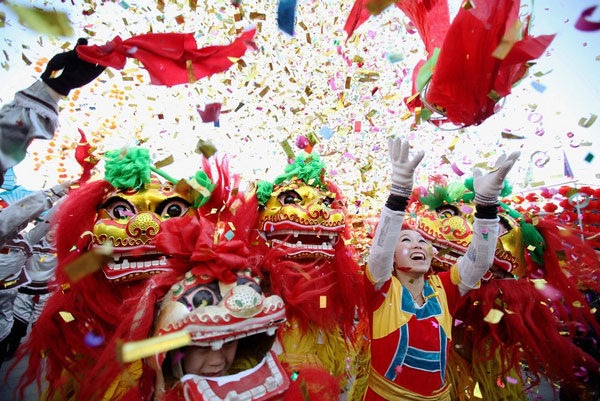 According to Vietnamese tradition, the first guest of the New Year in the house gives this house his good luck. The guest can also give money and receive money from the hosts. It is not recommended to hand over dollars and large bills. They also believe that it is necessary to wake up early on the first day of the New Year. The day starts with a trip to the temple where the Vietnamese eat Ban Chung.
According to Vietnamese tradition, the first guest of the New Year in the house gives this house his good luck. The guest can also give money and receive money from the hosts. It is not recommended to hand over dollars and large bills. They also believe that it is necessary to wake up early on the first day of the New Year. The day starts with a trip to the temple where the Vietnamese eat Ban Chung.
On subsequent holidays, adult relatives, friends, familiar families come to visit and can also give money for the well-being of children.
During Tet in Buddhist temples, the monks themselves give money to parishioners. They put money in little red bags too. This is like a gift of well-being from the Buddha, from God, for good luck. A Vietnamese aphorism says: "A bit of well-being from the Buddha is equal to a whole big basket of earthly well-being."
Every year more and more foreign tourists come to Tet in Vietnam. They see that despite the integration of the country into world processes and the economy, the Vietnamese carefully preserve their traditions.
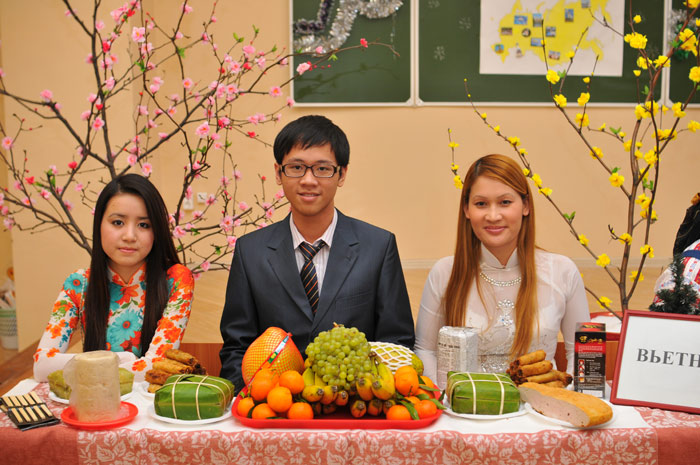 The Tet holiday appears in many Vietnamese works of art.
The Tet holiday appears in many Vietnamese works of art.
Much attention is paid to the celebration of the New Year according to the lunar calendar. The influence of the eastern horoscope on the fate of a person in recent years is perceived with less confidence than before.
In recent years, the tradition of meeting Tet only at home has become less unshakable than before, and many Vietnamese travel to other places, including abroad.
Dates of meetings of the New Year according to the Eastern calendar for the coming years:
- February 9, 2016 - Year of the Monkey
- January 28, 2017 - Year of the Rooster
- February 16, 2018 - Year of the Dog
- February 5, 2019 - Year of the Boar
- January 25, 2020 - Year of the Rat
